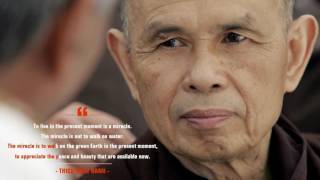Becoming Mindful Can Improve Your Health
On September 14, 2011, Buddhist monk Thich Nhat Hanh led a 3-hour workshop on being mindful.
After about an hour of music and introductions, Thich Nhat Hanh gives a talk, and answers questions for two hours. He explains how doing the exercises and rituals of mindfulness contribute to the path of optimal health and happiness.
He provides many insights on how people can practice being mindful in their daily lives, from walking to eating to washing the dishes.
Words From Thich Nhat Hanh on being Mindful:
Tips for Being Mindful:
“So to know the beauty of one’s own heart. So to be the caretaker, the custodian of your own heart, of your own mind. To take it seriously.
It’s a really precious resource, a precious part of who we are, and it’s very easy to take it for granted. It’s very easy to lose touch with it. It’s easy to get caught up in the day-to-day concerns.
Even in meditation it’s easy to get caught up in the ideas we have about what’s supposed to be happening and to get caught up trying to accomplish something and to not take in, or stay aware of, the quality of this heart-mind that’s always here.
The heart-mind always has a quality, almost always has an attitude, and almost always has a relationship to the details or to the big picture.
There is an attitude or relationship to life itself or what our life is about or who we are.
So to inquire what is this attitude, what is this relationship that we have, what is this quality of mind-heart that’s here.
And then it’s important to remember that the instructions that the Buddha gave place no emphasis whatsoever on judging or criticizing or being upset with what you see.
- Erin Zerbo (Author)
- English (Publication Language)
- 209 Pages – 10/26/2016 (Publication Date) – Amer Psychiatric Pub (Publisher)
Last update on 2025-09-30 / Affiliate links / Images from Amazon Product Advertising API
It’s really a phenomenal thing, it’s really an amazing thing, to just see how it is to be present and to see clearly. It’s so phenomenal to see clearly without judgment, without criticism, without trying to change it. I understand that kind of seeing as a kind of love, so even if what we see within us is unfortunate and maybe does not speak very well about who we are or what’s going on, there’s a way of being present for that, seeing it, and allowing it to be there.
Seeing it very clearly, and not being caught in it is actually an act of love in relationship to what we see. And slowly, I believe that what will happen is that we keep coming back, and trying to find that place of being present, and seeing the attitude that we have. We step back and we see the attitude, a very little bit at first perhaps.
We’re stepping out of the gravitational pull, out of the orbit of that attitude. We’re not caught by it and the act of seeing helps us to step out of it and because we’re not in it, the unhealthy attitudes and approaches begin to settle away, relax away, and amazingly enough, as we step back, the beautiful qualities of the mind-heart have a chance to shine and grow and become bigger and bigger.
One of the miracles of the human heart is that the act of attention—careful steady, ongoing mindfulness—has a way of unraveling those forces in the heart that cause suffering, and tends to augment or feed or nourish those forces in the heart that are the best in us.”
How to Be Mindful in Everyday Life
“So there is a dichotomy being looked at; the presence and absence; either it’s there or it’s not there. You can’t be partially pregnant they say. So either there is desire in the mind or there’s not desire. There’s not partial desire because partial desire is desire.
The instruction here is simply to notice the presence and absence of these things. And it’s very instructive that it doesn’t say “Notice the mind is characterized by lust, and then criticize yourself for that.” It doesn’t say “Notice the mind is filled with hate and then hate yourself for that, or justify the hatred.”
It is very simple—just notice the presence and absence. And there is an advantage in noticing the absence. Absence is kind of a strange thing, because absence is like nothing is there, right? You’re supposed to pay attention to what’s there.
But if something has been present for a while—a strong mood or mental state or attitude—it’s very helpful or instructive to get a sense of what the mind feels like when it’s not there.
And for one thing, knowing when it’s not there, really recognizing, “Oh it’s not there now” reinforces the value of it not being there. Perhaps you can feel that when the mind is not driven by hate, when the hate is no longer there, there is a higher quality of mind. It’s a more satisfying mind, a more peaceful mind.
And so it’s nice to see what the mind is like when it’s not filled with hate. Then when the hate reappears, that contrast helps to highlight it, helps you understand more deeply what’s going on.
Also, the more you can appreciate the absence of something, the more it’s like getting a massage. You’re getting used to the experience of not being caught in the grip of a particular mood or attitude.”
- Today, Master (Author)
- English (Publication Language)
- 134 Pages – 07/02/2021 (Publication Date) – Independently published (Publisher)
Last update on 2025-09-30 / Affiliate links / Images from Amazon Product Advertising API
Daily Mindfulness Exercises:
Doing A Mindful Breathing Exercise
This mindful exercise can be done standing up or sitting down, and pretty much anywhere at any time. All you have to do is be still and focus on your breath for just one minute.
Start by breathing in and out slowly. One cycle should last for approximately 6 seconds. Breathe in through your nose and out through your mouth, letting your breath flow effortlessly in and out of your body.
Let go of your thoughts for a minute. Let go of things you have to do later today or pending projects that need your attention. Simply let yourself be still for one minute.
Purposefully watch your breath, focusing your senses on its pathway as it enters your body and fills you with life, and then watch it work its way up and out of your mouth as its energy dissipates into the world.
If you are someone who thought they’d never be able to meditate, guess what? You are half way there already! If you enjoyed one minute of this mindful calming exercise, why not try two or three?










